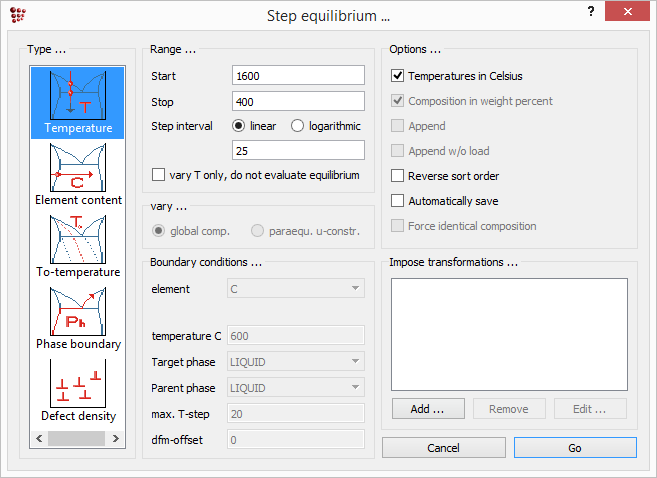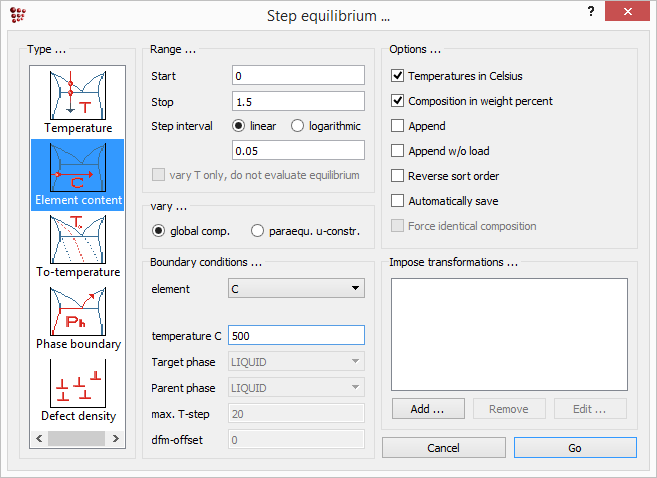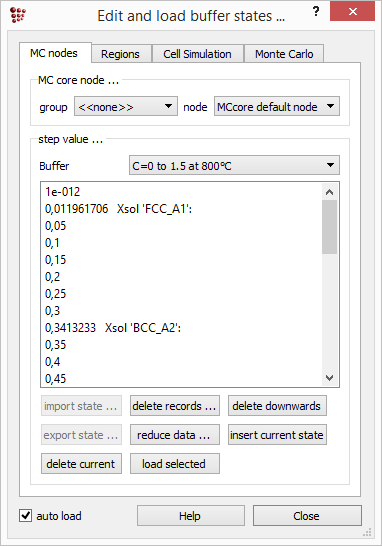This is an old revision of the document!
Table of Contents
T3: Stepped equilibrium calculations
This tutorial was tested on
MatCalc version 6.01 rel 1.003
license: free
database: mc_fe.tdb
Complimentary files
Click here to view the script for this tutorial.
Contents
- Re-opening a saved file and loading a calculation state
- Calculating a stepped equilibrium with varying temperature
- Understanding the results in the Output window
- Working with multiple buffers
- Calculating a stepped equilibrium with varying composition
- The “Edit buffer states” window
Before starting...
Re-open the file saved from Tutorial 2 and load the calculation state 'Equil @ 600°C'.
Stepped equilibrium calculation with varying temperature
Running the stepped calculation
In phase status window, remove graphite phase. Select 'Stepped calculation…' from the 'Calc' menu or click on the ![]() icon. The 'Step equilibrium' window will appear. Select 'Temperature' (the uppermost choice in the left-hand column).
icon. The 'Step equilibrium' window will appear. Select 'Temperature' (the uppermost choice in the left-hand column).
In the 'Range' box, the default 'Start', 'Stop' and 'Step interval' values are 400, 1600 and 25 respectively. Keep these values and verify that the 'Temperatures in Celsius' option has been selected. The step direction is unimportant, and it is not necessary to enter the interval as '-25' if stepping in a negative direction. The contents of the 'Vary' and 'Boundary conditions' boxes are currently greyed-out because they are not applicable to a temperature-step calculation. Click on the 'Go' button at the bottom right of the window.
Output
The 'console' window should show the following series of messages:
1, 0,00 s, 600,00 C (873,15 K), its 2, BCC_A2 CEMENTITE - OK - 2, 0,00 s, 625,00 C (898,15 K), its 4, BCC_A2 CEMENTITE - OK - 3, 0,00 s, 650,00 C (923,15 K), its 4, BCC_A2 CEMENTITE - OK - 4, 0,00 s, 675,00 C (948,15 K), its 4, BCC_A2 CEMENTITE - OK - 5, 0,00 s, 700,00 C (973,15 K), its 4, BCC_A2 CEMENTITE - OK - 6, 0,00 s, 725,00 C (998,15 K), its 4, BCC_A2 CEMENTITE - OK - Tsol 'FCC_A1': 726,53 C (999,68 K) iter: 4, time used: 0,00 s Tsol 'CEMENTITE': 726,53 C (999,68 K) iter: 5, time used: 0,00 s 7, 0,01 s, 750,00 C (1023,15 K), its 5, FCC_A1 BCC_A2 - OK - 8, 0,00 s, 775,00 C (1048,15 K), its 5, FCC_A1 BCC_A2 - OK - Tsol 'BCC_A2': 787,14 C (1060,29 K) iter: 4, time used: 0,00 s 9, 0,00 s, 800,00 C (1073,15 K), its 4, FCC_A1 - OK - 10, 0,00 s, 825,00 C (1098,15 K), its 2, FCC_A1 - OK - 11, 0,00 s, 850,00 C (1123,15 K), its 2, FCC_A1 - OK - 12, 0,00 s, 875,00 C (1148,15 K), its 2, FCC_A1 - OK - 13, 0,00 s, 900,00 C (1173,15 K), its 2, FCC_A1 - OK - 14, 0,00 s, 925,00 C (1198,15 K), its 2, FCC_A1 - OK - 15, 0,00 s, 950,00 C (1223,15 K), its 2, FCC_A1 - OK - 16, 0,00 s, 975,00 C (1248,15 K), its 2, FCC_A1 - OK - 17, 0,00 s, 1000,00 C (1273,15 K), its 2, FCC_A1 - OK - 18, 0,00 s, 1025,00 C (1298,15 K), its 2, FCC_A1 - OK - 19, 0,00 s, 1050,00 C (1323,15 K), its 2, FCC_A1 - OK - 20, 0,00 s, 1075,00 C (1348,15 K), its 2, FCC_A1 - OK - 21, 0,00 s, 1100,00 C (1373,15 K), its 2, FCC_A1 - OK - 22, 0,00 s, 1125,00 C (1398,15 K), its 2, FCC_A1 - OK - 23, 0,00 s, 1150,00 C (1423,15 K), its 2, FCC_A1 - OK - 24, 0,00 s, 1175,00 C (1448,15 K), its 2, FCC_A1 - OK - 25, 0,00 s, 1200,00 C (1473,15 K), its 2, FCC_A1 - OK - 26, 0,00 s, 1225,00 C (1498,15 K), its 2, FCC_A1 - OK - 27, 0,00 s, 1250,00 C (1523,15 K), its 2, FCC_A1 - OK - 28, 0,00 s, 1275,00 C (1548,15 K), its 2, FCC_A1 - OK - 29, 0,00 s, 1300,00 C (1573,15 K), its 2, FCC_A1 - OK - 30, 0,00 s, 1325,00 C (1598,15 K), its 2, FCC_A1 - OK - 31, 0,00 s, 1350,00 C (1623,15 K), its 2, FCC_A1 - OK - 32, 0,00 s, 1375,00 C (1648,15 K), its 2, FCC_A1 - OK - 33, 0,00 s, 1400,00 C (1673,15 K), its 2, FCC_A1 - OK - 34, 0,00 s, 1425,00 C (1698,15 K), its 2, FCC_A1 - OK - 35, 0,00 s, 1450,00 C (1723,15 K), its 2, FCC_A1 - OK - Tsol 'LIQUID': 1453,06 C (1726,21 K) iter: 3, time used: 0,00 s 36, 0,00 s, 1475,00 C (1748,15 K), its 3, LIQUID FCC_A1 - OK - Tsol 'FCC_A1': 1494,61 C (1767,76 K) iter: 4, time used: 0,00 s Tsol 'BCC_A2': 1494,61 C (1767,76 K) iter: 5, time used: 0,00 s 37, 0,00 s, 1500,00 C (1773,15 K), its 5, LIQUID BCC_A2 - OK - Tsol 'BCC_A2': 1505,65 C (1778,80 K) iter: 4, time used: 0,00 s 38, 0,00 s, 1525,00 C (1798,15 K), its 4, LIQUID - OK - 39, 0,00 s, 1550,00 C (1823,15 K), its 2, LIQUID - OK - 40, 0,00 s, 1575,00 C (1848,15 K), its 2, LIQUID - OK - 41, 0,00 s, 1600,00 C (1873,15 K), its 2, LIQUID - OK - changing step direction ... 42, 0,00 s, 575,00 C (848,15 K), its 5, BCC_A2 CEMENTITE - OK - 43, 0,00 s, 550,00 C (823,15 K), its 5, BCC_A2 CEMENTITE - OK - 44, 0,00 s, 525,00 C (798,15 K), its 5, BCC_A2 CEMENTITE - OK - 45, 0,00 s, 500,00 C (773,15 K), its 5, BCC_A2 CEMENTITE - OK - 46, 0,00 s, 475,00 C (748,15 K), its 5, BCC_A2 CEMENTITE - OK - 47, 0,00 s, 450,00 C (723,15 K), its 5, BCC_A2 CEMENTITE - OK - 48, 0,00 s, 425,00 C (698,15 K), its 5, BCC_A2 CEMENTITE - OK - 49, 0,00 s, 400,00 C (673,15 K), its 5, BCC_A2 CEMENTITE - OK - Steps: 50, CalcTime: 0,11 s AktStepVal: 673,150000 - OK -
Each line corresponds to an equilibrium calculated at a single temperature value and comprises a line number, the calculation time, the temperature, the number of iterations, the stable phases at that temperature and an '- OK -' message indicating that the equilibrium calculation was successful.
Note that the temperature-stepping starts from the equilibrium at 600°C loaded from the calculation state. Initially, the temperature is increased by the 'Step interval' each time until the upper temperature limit is reached.
Then, a 'changing step direction' message is displayed and, again starting from the equilibrium at 600°C, the temperature is decreased until the lower limit is reached.
Also note the lines beginning with 'Tsol': phase solubility temperatures are automatically evaluated during the stepped calculation. Thus it is seen in the output above that from 600°C to 726.53°C, the two stable phases are BCC_A2 (ferrite) and CEMENTITE. At 726.53°C, FCC_A1 (austenite) becomes stable, and cementite becomes unstable. The two phases in equilibrium are ferrite and austenite between this temperature and 787.14°C, when ferrite becomes unstable. Austenite is then the only stable phase, and this situation persists up to the liquid solubility temperature of 1453.06°C. The BCC_A2 phase known as delta-ferrite is stable in a narrow temperature range at high temperature, and by 1600°C the only equilibrium phase is liquid. There are no changes in phase stability between 600°C and 400°C, as can be seen from the block of lines below 'changing step direction …'.
The final three lines of output give the number of steps and total calculation time, the current value of the stepped variable (673.15 K = 400°C) and an 'OK' message indicating that the calculation was carried out successfully.
The contents of the 'Phase summary' and 'Phase details' are not modified during the stepped calculation, but still display the information loaded from the calculation state 'Equil @ 600°C'.
Buffers
All the equilibria listed above are stored in a buffer. In other words, a buffer is a collection of calculation states, with each calculation state created at a different temperature. The default buffer is named '_default_', and its contents are overwritten when a new stepped calculation is carried out.
To be able to keep more than one set of stepped equilibria, additional buffers must be created. Firstly, rename the existing default buffer using 'Global > Buffers > Rename'. Type 'T=400 to 1600°C' into the 'New buffer name' box and click 'OK'. Then, create a new buffer using 'Global > Buffers > Create'. This new buffer will contain the results from a new stepped equilibrium calculation in which the carbon content is varied from 0 to 1.5 wt.% at 500°C, so enter the name 'C=0 to 1.5 at 500°C'. Note that buffers can be selected from the drop-box in the toolbar area or using 'Global > Buffers > Select'.
Stepped equilibrium calculation with varying carbon content
Running the calculation
Calculate an equilibrium at 500°C. Open the 'Step equilibrium' window again, but this time select 'Element content' instead of 'Temperature' in the 'Type' box. Enter '0', '1.5' and '0.05' respectively as the start, stop and step interval values. (Note that, as shown in the image below, MatCalc accepts either a decimal point or a comma as the decimal separator.) In the 'Boundary conditions' box, ensure that the element selected is 'C', and enter the temperature as '500'. Ensure that in the 'vary' box, 'global comp' is selected, and that in the 'Options' column, 'Temperatures in Celsius' and 'Composition in weight percent' are both selected, then click on 'Go'.
The contents of the 'console' window should appear as follows:
1, 0,00 s, 0,4, its 9, BCC_A2 CEMENTITE - OK - 2, 0,00 s, 0,45, its 2, BCC_A2 CEMENTITE - OK - 3, 0,00 s, 0,5, its 2, BCC_A2 CEMENTITE - OK - 4, 0,00 s, 0,55, its 2, BCC_A2 CEMENTITE - OK - 5, 0,00 s, 0,6, its 2, BCC_A2 CEMENTITE - OK - 6, 0,00 s, 0,65, its 2, BCC_A2 CEMENTITE - OK - 7, 0,00 s, 0,7, its 2, BCC_A2 CEMENTITE - OK - 8, 0,00 s, 0,75, its 2, BCC_A2 CEMENTITE - OK - 9, 0,00 s, 0,8, its 2, BCC_A2 CEMENTITE - OK - 10, 0,00 s, 0,85, its 2, BCC_A2 CEMENTITE - OK - 11, 0,00 s, 0,9, its 2, BCC_A2 CEMENTITE - OK - 12, 0,01 s, 0,95, its 2, BCC_A2 CEMENTITE - OK - 13, 0,00 s, 1, its 2, BCC_A2 CEMENTITE - OK - 14, 0,00 s, 1,05, its 2, BCC_A2 CEMENTITE - OK - 15, 0,00 s, 1,1, its 2, BCC_A2 CEMENTITE - OK - 16, 0,00 s, 1,15, its 2, BCC_A2 CEMENTITE - OK - 17, 0,00 s, 1,2, its 2, BCC_A2 CEMENTITE - OK - 18, 0,00 s, 1,25, its 2, BCC_A2 CEMENTITE - OK - 19, 0,00 s, 1,3, its 2, BCC_A2 CEMENTITE - OK - 20, 0,00 s, 1,35, its 2, BCC_A2 CEMENTITE - OK - 21, 0,00 s, 1,4, its 2, BCC_A2 CEMENTITE - OK - 22, 0,00 s, 1,45, its 2, BCC_A2 CEMENTITE - OK - 23, 0,00 s, 1,5, its 2, BCC_A2 CEMENTITE - OK - changing step direction ... 24, 0,00 s, 0,35, its 2, BCC_A2 CEMENTITE - OK - 25, 0,00 s, 0,3, its 2, BCC_A2 CEMENTITE - OK - 26, 0,00 s, 0,25, its 2, BCC_A2 CEMENTITE - OK - 27, 0,00 s, 0,2, its 2, BCC_A2 CEMENTITE - OK - 28, 0,00 s, 0,15, its 2, BCC_A2 CEMENTITE - OK - 29, 0,00 s, 0,1, its 2, BCC_A2 CEMENTITE - OK - 30, 0,00 s, 0,05, its 2, BCC_A2 CEMENTITE - OK - Xsol 'CEMENTITE': X(C): 5,7389141e-005, WP(C): 0,0012343224 - OK - 31, 0,00 s, 1e-012, its 4, BCC_A2 - OK - Steps: 32, CalcTime: 0,07 s AktStepVal: 0,000000 - OK -
Similarly to the temperature-step calculation, the output consists of a series of equilibria evaluated at the specified step-values. The first of these corresponds to the carbon content of 0.4 wt.% entered in the 'System composition' box in Tutorial 2. The carbon content is then increased in 0.05 wt.% steps up to the maximum value of 1.5 wt.%. The 'Changing step direction' line marks the beginning of the second set of equilibria, in which the carbon content is decreased.
At 500°C, the stable phases are BCC_A2 and CEMENTITE across almost the whole composition range, but between the final two equilibria there is a line beginning with 'Xsol'. The line below this gives the carbon content at which cementite becomes unstable, both in mole fraction 'X(C)' and in weight percent 'WP(C)'.
Create a third buffer named 'C=0 to 1.5 at 800°C' and perform a stepped calculation with the same composition range but at a temperature of 800°C. The output in this case includes three 'Xsol' lines, corresponding to changes in phase stability:
1, 0,00 s, 0,4, its 23, FCC_A1 - OK - 2, 0,00 s, 0,45, its 3, FCC_A1 - OK - 3, 0,00 s, 0,5, its 3, FCC_A1 - OK - 4, 0,00 s, 0,55, its 3, FCC_A1 - OK - 5, 0,00 s, 0,6, its 3, FCC_A1 - OK - 6, 0,00 s, 0,65, its 3, FCC_A1 - OK - 7, 0,00 s, 0,7, its 3, FCC_A1 - OK - 8, 0,00 s, 0,75, its 3, FCC_A1 - OK - 9, 0,00 s, 0,8, its 3, FCC_A1 - OK - 10, 0,00 s, 0,85, its 3, FCC_A1 - OK - 11, 0,00 s, 0,9, its 3, FCC_A1 - OK - Xsol 'CEMENTITE': X(C): 0,042617353, WP(C): 0,94829227 - OK - 12, 0,00 s, 0,95, its 4, FCC_A1 CEMENTITE - OK - 13, 0,00 s, 1, its 2, FCC_A1 CEMENTITE - OK - 14, 0,00 s, 1,05, its 2, FCC_A1 CEMENTITE - OK - 15, 0,00 s, 1,1, its 2, FCC_A1 CEMENTITE - OK - 16, 0,00 s, 1,15, its 2, FCC_A1 CEMENTITE - OK - 17, 0,00 s, 1,2, its 2, FCC_A1 CEMENTITE - OK - 18, 0,00 s, 1,25, its 2, FCC_A1 CEMENTITE - OK - 19, 0,00 s, 1,3, its 2, FCC_A1 CEMENTITE - OK - 20, 0,00 s, 1,35, its 2, FCC_A1 CEMENTITE - OK - 21, 0,01 s, 1,4, its 2, FCC_A1 CEMENTITE - OK - 22, 0,00 s, 1,45, its 2, FCC_A1 CEMENTITE - OK - 23, 0,00 s, 1,5, its 2, FCC_A1 CEMENTITE - OK - changing step direction ... 24, 0,00 s, 0,35, its 3, FCC_A1 - OK - Xsol 'BCC_A2': X(C): 0,015675087, WP(C): 0,3413233 - OK - 25, 0,00 s, 0,3, its 4, FCC_A1 BCC_A2 - OK - 26, 0,00 s, 0,25, its 2, FCC_A1 BCC_A2 - OK - 27, 0,00 s, 0,2, its 2, FCC_A1 BCC_A2 - OK - 28, 0,00 s, 0,15, its 2, FCC_A1 BCC_A2 - OK - 29, 0,00 s, 0,1, its 2, FCC_A1 BCC_A2 - OK - 30, 0,00 s, 0,05, its 2, FCC_A1 BCC_A2 - OK - Xsol 'FCC_A1': X(C): 0,00055593532, WP(C): 0,011961706 - OK - 31, 0,00 s, 1e-012, its 4, BCC_A2 - OK - Steps: 32, CalcTime: 0,07 s AktStepVal: 0,000000 - OK -
Edit buffer states
The 'console' window provides information on which phases are stable at a given temperature and carbon content, but not on the phase fractions or compositions. However, this detailed information is stored in the buffers and can be found by selecting 'Global > Buffers > Edit buffer states'.
The upper part of the 'step value…' area contains a drop-box for selecting a buffer, and the lower part gives a list of the step-values at which equilibria have been evaluated. These are either temperature or carbon content values, depending on the buffer chosen, and their units are those specified in the 'Step equilibrium' window when setting up the calculation. The 'Tsol' or 'Xsol' values are also stored. If the 'auto load' box at the bottom left is ticked, clicking on a step-value loads the equilibrium, and the contents of the 'Phase summary' and 'Phase details' are immediately updated with phase fraction and composition details for this equilibrium. The next two tutorials demonstrate how to produce graphical plots of phase fractions, compositions and many other quantities as a function of the stepped variable.
To finish...
Save the workspace file - it will be needed again in Tutorial 4.
Consecutive articles
The tutorial is continued in article T4 - Graphical presentation and export of results
Go to MatCalc tutorial index.



